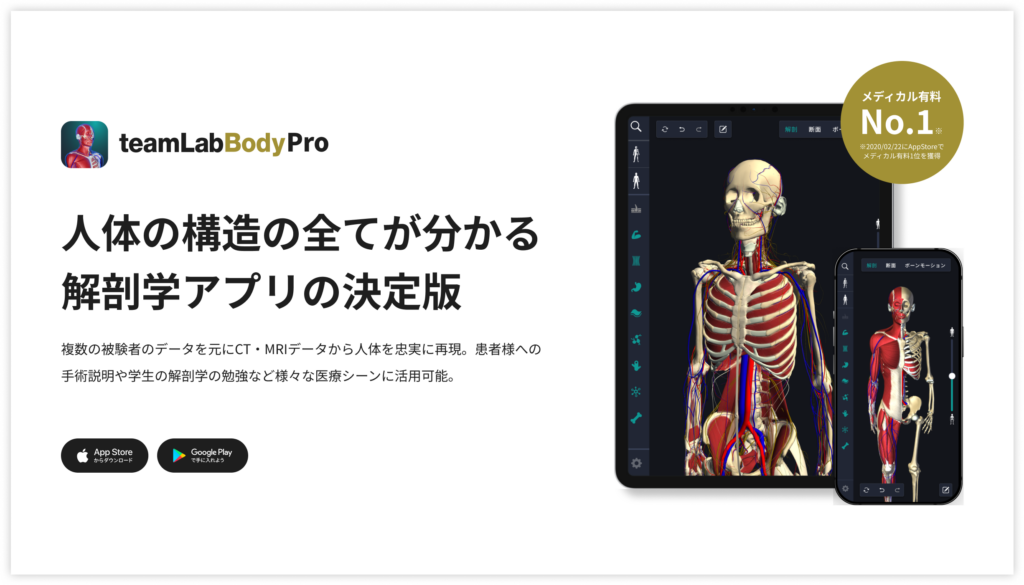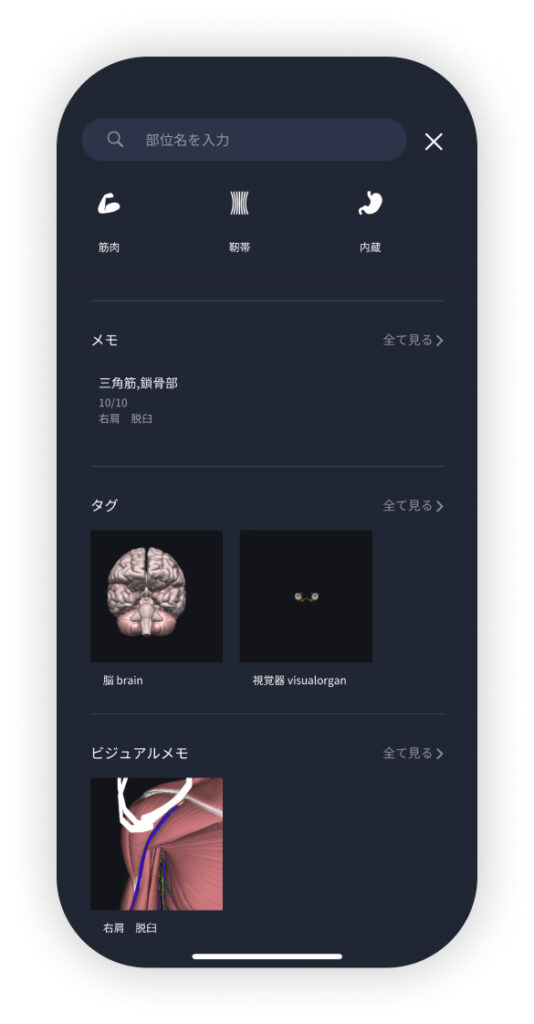beginning
In this article, I will explain effective study methods, starting with knowledge of specialized parts in human anatomy.
In human anatomy, it is necessary not only to memorize the names of various organs, muscles, and bones, but also to remember where they are located in the body. Therefore, it is necessary to learn as efficiently as possible.
I hope you will deepen your understanding even a little by reading this article and using the app.
Now, I will explain the contents of the “levator superior eyelid muscle” and how to study human anatomy.
teamLab Body Pro Free Download
A 3D anatomy app that shows all the structures of the human body
Download teamLab Body Pro here!

What is levator superior eyelid muscle?
The anatomy application allows you to view a selection of anatomy 3D models. In this model, there are various observation methods such as surfaces, cross-sections, and nervous systems. This time, I'll explain using an anatomy application.
About levator superior eyelid muscle

levator superior eyelid muscle(Levator palpebrae superioris muscle) is an important muscle that controls the opening and closing of the eyes, and plays a role in pulling up the upper eyelid.
This muscle is directly involved in eyelid (eyelid) movement and is very important for maintaining vision. The levator superior eyelid muscle starts from the sphenoid bone of the skull and stops at the back of the upper eyelid. Its main function is to expose the eyeballs and ensure visibility by raising the eyelids.
It is also important for movements to open the eyes wide, and it is also involved in emotions and facial expressions. This muscle is mainlyoculomotor nerveIt is governed by When the levator upper eyelid muscle is damaged or when nerve problems occur, the upper eyelid is lowered,ptosisIt becomes a state called (ptosis). Since ptosis interferes with vision and can reduce patients' quality of life, clinical evaluation is important.
Study points
Anatomical understanding: accurately capture structure and positional relationships
The levator superior eyelid muscle starts from the sphenoid bone of the skull and stops at the back of the eyelid. In order to understand how this muscle runs, it is important to understand the anatomical structure around the eye. It is basic to remember clearly where muscles begin and stop.
Understanding is deepened by checking the position of this muscle and its relationship with surrounding structures using 3D anatomy apps and human models. Also, it's a good idea to learn positional relationships with other muscles around the eyes (such as the orbicularis orbitalis muscle) at the same time.
Functional understanding: learning in relation to movement
The role of the levator superior eyelid muscle is to secure visibility by raising the eyelids. By actually opening your eyes and keeping your eyes open, you can experience how these muscles work.
In learning, let's move the eyelids consciously and check how the contraction of the levator palpebral muscle lifts the eyelids. In particular, understanding how ptosis occurs makes it easier to realize the importance of this muscle.
Practical application: deepening from clinical relationships
Dysfunction of the levator superior eyelid muscle may cause ptosis. In clinical settings, it is necessary to evaluate whether the cause of ptosis is a problem with the levator eyelid muscle or neurological abnormalities. In particular, when the oculomotor nerve is damaged, abnormalities appear in the movement of the levator eyelid muscle, so it is important to understand the function of this muscle in order to accurately diagnose the patient's condition.
In the treatment of ptosis, surgery to restore the function of the levator upper eyelid muscle may be performed, so a deep understanding of the anatomy and function of the muscle is useful for diagnosis and treatment.
How to study human anatomy
I will explain specific study methods using human anatomy applications.
Check your past learning history and practice repeatedly
Here are the steps to check your anatomy learning history and practice iteratively effectively.
1. Check your learning history in the app
Reviewing your learning history with the application is an important step in effectively advancing anatomy learning. First, launch the app and go to the learning history section from the main menu. Many anatomy apps are designed to show your progress in the form of graphs and lists, so you can visually check which parts you've learned about and how much time you've spent.
By using this data, you can understand which areas you have strengths in and where you need to spend more time and effort. We also recommend using a dedicated tag or notebook function to mark areas you are particularly weak at or where you need to relearn. Regularly checking your learning history and looking back on past learning content will lead to efficient review and deepening understanding.
2.Make a plan for iterative learning
Making an efficient repetitive learning plan based on learning history is extremely effective in promoting knowledge retention. First, identify weak points and areas where you need to relearn. Next, arrange these study items into a weekly or monthly calendar and create a specific study schedule. By proceeding in a planned manner, you can learn each part evenly and avoid packing in a large amount of information at once.
Using a task management app or digital calendar to set study reminders is effective. Also, it's important to have the flexibility to regularly review progress and revise plans as needed. By having goals and proceeding with your studies in a planned manner, you can efficiently acquire anatomical knowledge.
3.Use 3D features to learn visually
By utilizing the 3D function, learning anatomy is easier to understand visually. The 3D model shows the structure of the human body three-dimensionally, and each part can be observed in detail. This makes it possible to intuitively grasp positional relationships between deep muscles and organs that are difficult to capture in a planar view. For example, you can learn even the smallest details by rotating specific muscles and bones and zooming in and out.
Also, there are many apps that have the function of displaying cross-sectional views of each part using a 3D model, which is useful for deepening understanding of internal structures. This diversity of visual information helps with memory retention and improves immediate responsiveness in tests and practice situations. By utilizing the 3D function and learning visually, you can learn anatomy knowledge more deeply and efficiently.
Use the memo function concretely

Make notes so you don't forget the things and points you've noticed while studying. The memo function can be used for different purposes, such as inputting text, saving images, and writing memos. Tag your notes to make them easier to review later.
Test your learning regularly in the form of quizzes
Regularly testing what you've learned in a quiz format is a very effective way to anchor your anatomy knowledge. Quiz-style tests help you objectively grasp your level of understanding and areas you lack while repeating knowledge.
For example, by using a learning app to conduct quizzes every specific period, you can reconfirm what you've learned and strengthen your memory. There are a wide range of quiz formats, such as multiple choice questions, fill-in-the-blank questions, and short answer questions, and each helps understanding from a different angle and develops the ability to utilize various types of knowledge.
Get feedback
If possible, get feedback from other learners and experts. It helps you find your own gaps in understanding and areas for improvement. You can also keep yourself motivated to learn by regularly testing yourself. Feeling a sense of accomplishment and progress increases motivation for continuous learning.
summary
This time, I explained how to study “levator superior eyelid muscle” using an application!
Thank you for reading this far.
I would be happy if reading this article helped you learn about anatomy.
Learning is a long, never-ending journey, but I sincerely wish you all the best. Let's continue to study together and work hard for the national exam!
Please look forward to the next blog.
teamLab Body Pro Free Download
A 3D anatomy app that shows all the structures of the human body
Download teamLab Body Pro here!





